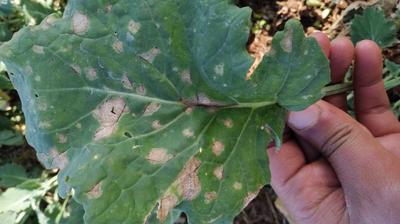Ring Spot
Mycosphaerella brassicicola
Fungus
In a Nutshell
- Dark spots surrounded by yellow halo.
- Concentric dark rings inside the spots.
- Yellowing of leaves.
- Premature defoliation.
Can also be found in
Symptoms
Normally symptoms are more common on older leaves, but if younger leaves are affected the symptoms become more severe. Initially small dark spots of 3-5 mm, surrounded by a yellow halo are seen on the leaf surfaces. They are green-brown or grey-black and limited by the leaf veins and eventually become 2-3 cm big. Tiny dark dots form concentric rings inside the spots. Spots may coalesce causing yellowing of the leaf. Under severe infestation it may lead to premature defoliation. Spots caused by Ring spot fungus look similar to those caused by alternaria species. The main difference is that ring spot lesions are grey and they contain black, pinhead dots in concentric rings. All above ground portions of the plant may show symptoms. Individual lesions have dark concentric rings, from black fruiting bodies, with definite edges surrounded by a yellowish zone. Under severe attacks the spots coalesce, and the entire plant may be affected and blackened. In seed stalks, the fungus causes a distortion similar to the injury caused by the herbicide 2,4-D. Dark lesions may develop on stored cabbage and may penetrate deeply.
Recommendations

Organic Control
To this day, we are not aware of any biological control method available against this disease. If you know of any successful method to reduce the incidence or the gravity of the symptoms, please contact us.

Chemical Control
Always consider an integrated approach with preventive measures together with biological treatments if available. Treat your seeds pre-planting with thiram or mancozeb. During cool and moist weather apply sprays of chlorothanonil, mancozeb or copper. It is a difficult disease to control where intense vegetable production is done due to large numbers of airborne spores where environmental conditions are cool and wet, favoring spread and infection.
What caused it?
The damage is caused by the airborne pathogen Mycosphaerella brassicicola. The spores are spread by water splashes, wind and rain. The fungus needs a period of 100% relative humidity lasting at least four days for reproduction. Temperatures of 16-20°C and poor soil drainage can support the growth of the pathogen. The disease is a problem mostly with seed production, and seeds may carry the pathogen. The fungus also overwinters on infected weed and crop hosts or in residues. Spores are spread by wind. Cool moist weather favors disease development.
Preventive Measures
- Use resitant varieties if available.
- Monitor your nursery for leaf spots, remove infected leaf, or if more leaves present spots, destroy the seedling.
- Only plant healthy seedlings on your field.
- Remove and destroy weeds from and around your field, as they can be alternative hosts.
- Collect and destroy crop residues by burning or burying.
- Alternatively you can plow the affected residues.
- Wait until the residues are completely rotted before replanting on the field.
- Consider crop rotating for 2-3 years with a non-host crop.
- Treat seed with hot water at 122°F for 30 minutes.
- This serves to eliminate seed borne innoculum.
- Treat a small quantity of each seed lot, and test germination before treating all seed.



